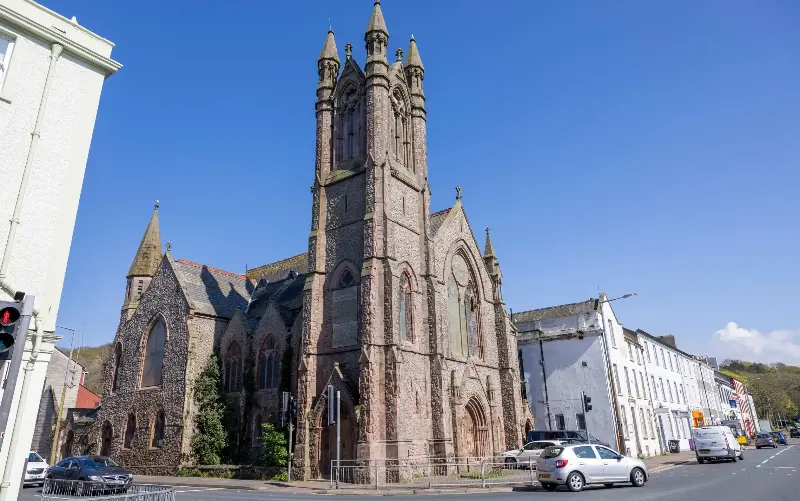
Whitehaven is a town by the sea but not a seaside town. The first designed town in England since the Middle Ages, it was built in the 1660s. Its strong character captivated me in a way no town has for years.
Holidaymakers do not flock here but to the Lake District a few miles inland. The train journey from London took six hours via the enjoyably slow line from Carlisle down the coast of Cumberland. It is still open, I suspect, because it serves nearby Sellafield nuclear power station.
Sellafield pays good salaries; otherwise, in central Whitehaven, 15 per cent of people are claiming Universal Credit and housing can be poor. Yet the glorious streets of Georgian houses near the harbour were preserved by poverty – the recession from 1800, when the tobacco trade dried up, ensuring that these old houses were not replaced with grand Victorian buildings.
The small grid of streets was the brainchild of the local landowner Sir John Lowther, who was in his 20s in the 1660s. He sent detailed instructions to his agent from London, where fellow members of the Royal Society, Sir Christopher Wren and Robert Hooke, were planning the rebuilding of London after the Great Fire of 1666.
Whitehaven had 84 households in 1667, 2,281 people by 1696 and 9,063 by 1762. Its greatest prosperity came in the 1740s, from exporting coal mined right by the harbour and importing tobacco, for which this was the main port after London. Coal exports peaked at 400,000 tons in 1928. A new mine was cancelled this year after a court ruling on government net-zero legislation.
The principal thoroughfare, Lowther Street, runs from the castle (once the Lowthers’ house) to the harbour. Sir John laid out Lowther Street in 1685, 48ft wide.
Houses, built by their owners, had to follow a building line on the street with no gaps between them. Windows were to have stone transoms and doors hewn stonework. Sir John refused permission for a back ally to King Street because such things were “commonly nothing but a sink of nastiness”. The square he built round the new St Nicholas’s Church on Lowther Street was the earliest in the country, outside London.
From 1706 his son, James, continued the development of fine but modest houses. In modern times many were washed in a variety of colours, adding a fortuitous attraction.
During my visit, it was so cold in my lodgings that I went out for a walk in my overcoat in the middle of the night. Unlike London, there were no street sleepers visible, in fact no one at all, and no traffic but a police car. In the moonlight the terraces of Scotch Street and Irish Street looked like theatre sets, their varied 18th-century doorways framed with columns and pediments. From shabby first floor rooms with makeshift curtains came chance nocturnal voices.
Of the churches the Lowthers provided, Holy Trinity (1715) was demolished in 1949; St Nicholas (rebuilt 1883) on Lowther Street burned down in 1971, leaving a surprisingly pleasing tower in its green churchyard. The gem is light and tranquil St James’s (1753), on the valley side – “the finest Georgian church interior in the county,” said the great architectural historian Sir Nikolaus Pevsner.
In 1970 only 36 per cent of buildings in Whitehaven were sound and 34 per cent derelict. The old industrial area west of the harbour was almost obliterated. Little evidence remains of King Pit, which, in 1793, was the deepest in the world at 160 fathoms, or of Saltom Pit, the first to extend under the sea, in 1729. However, Wellington Lodge survives – a crenellated tower of the 1840s by the architect Sydney Smirke, who was commissioned to design Gothic pithead buildings for the prominent site above the harbour.
Whole areas of 18th-century houses were demolished by 1970, when it was realised that if this continued there’d be nothing left. Since then gradual renovation has made the vital difference between a ghost town and an historic setting for local people to develop a future.
Lowther Street boasts three rare gems. The first is Michael Moon’s shop, which has been “finding new homes for old books since 1970”. It has 13 rooms and stalagmites of old volumes.
Behind the counter I found Peter Moon, wisely wearing a quilted gilet under his tweed jacket against the spring chill and dealing with postal sales. His father Michael kindly walked round from his home to join us.
Michael Moon’s mind is wryly humorous. His trade flyer lists some things he doesn’t sell: “Donkey stones, tins of dubbin, laminated shims, koi carp, flensing knives, canopic jars…” But not only does he sell books, he publishes them. Of his 55 historical reprints, all sold except for Annals of the Solway by George Neilson (1896). Few live on the Solway Firth who might want to buy it.
A few doors down, the flourishing independent Dixons department store occupies a string of old stone houses. (From the slate roof, seagulls dislodge wisps of moss which garnish the pavement.)
In many towns a defunct chain department store leaves a gap in the urban dentition. Dixons brings shoppers into the town centre.
The third nice surprise was Richardson’s wine shop. The model train looping round the 19th-century shop window caught my eye. Then I saw the Whitehaven labelled wine. Surely wine can’t be grown here?
Gerard Richardson put me right in his little office behind the counter. “The Whitehaven is a sauvignon blanc from the Marlborough district of New Zealand. They started approximately the same time as our business, 1995, and we have stocked all their vintages.” It sells at £20.95.
As supermarkets competed to sell cheaper wine, Mr Richardson went up market. He relishes contrary success. “We want to be old-fashioned,” he said, nodding at the old coffee-roasting machine. “We dropped Mondays as a shop day. Trade went up. We closed at 3pm. Trade went up.”
Mr Richardson is friendly and unassuming, but served for 19 years as a Justice of the Peace and is a deputy lieutenant of the county. Together with his shop partner, Louise Savage, he has published books on Whitehaven in old photographs. He was behind the Maritime Festivals from 1999 that brought thousands of visitors (the late Queen among them) to the harbour. He kept the festivals going till 2015, when Health & Safety interference made hosting the event a nightmare.
Two giant silos on the harbour were demolished in 1992 (formerly used by the popular employer Marchon, which made phosphoric and sulphuric acid). Since 1998 a marina has provided 400 berths for private vessels and a pontoon for commercial craft. I spotted the local fishing vessels Galatea (WA5) and Kinloch (WA35). Since 2022, though, Queen’s Marina has turned brown with iron ochre, apparently from water draining a nearby railway tunnel.
Some building losses have been shocking. In the 1970s, to make way for a 42,000 sq ft Co-op superstore, one side of the Georgian Church Street and one side of the Georgian Queen Street were demolished for a whole block. Wilkinsons took over from the Co-op; but then closed in 2023.
The Post Office in Lowther Street closed in 1994 and in 2020 a huge cannabis farm was discovered in the building. HSBC next door closed in 2022 and NatWest two doors down in 2023. The Methodist Church in Lowther Street remains an attractive feature of the skyline, but it closed in 1996 and last year the interior was mouldering and full of water.
Off Lowther Street, King Street, once bustling, now has empty and derelict shops. For weekly shopping most go to Morrisons on one edge of the historic centre, or Tesco, beside the railway station.
A strength of Whitehaven is its distinctive culture. I popped into Cross’s Coffee Shop (“Estd 1895”) in old Roper Street and pointed to a tempting pastry. The cheery waitress looked at me as if I were a Martian, but said, “Oh, currant cake.” It’s a variant of Eccles cake, with no lid. Jane Grigson has a recipe.
Further up Roper Street, the 17th century No 54 has been restored, its walls washed a tasteful maroon. But the shop below is empty. Within living memory this was R Brew’s clog shop, its window full of wooden shoes. I did see whippets in the town, but no clogs.
Whitehaven narrowly escaped the desolation of other post-industrial towns.
Its wonderful historic kernel has been rehabilitated only thanks to the commitment of local people in and around Lowther Street.
